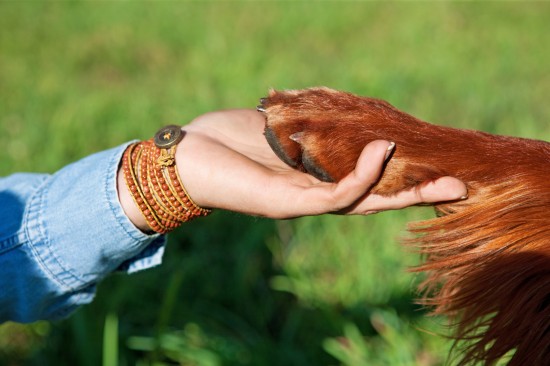

When we as people walk, we tend to place most of our weight evenly across the whole of our feet in turn, using the toes for balance and the heel for support. However, if you have ever looked closely at the way that your dog walks (and they have slowed down enough to make this possible!) you may have noticed that dogs appear to carry their weight forwards, and as if they are placing most of their weight on their toes.
This becomes easier to observe if you look at the hind legs and feet when your dog is standing still or walking slowly, as the heel will look as if it is not actually in contact with the ground, and is instead projecting outwards to the rear. This is due to a bone called the calcaneus, or heel bone, which essentially supports the main part of the body’s weight, providing balance and stability. While the calcaneus bone is very small in itself, it fulfils an important role in keeping your dog mobile, and if injured or damaged, can lead to a very pronounced limp.
In this article, we will look at the role of the calcaneus and the tendons that lead up from it, and some potential problems that can develop. Read on to learn more!
If you can catch your dog asleep or relaxed enough to allow you to get a good look at their feet and limbs, you can trace the bones and tendons in the rear legs with relative ease.
Run your finger from the ground up the back of the paw, until you reach the bone that juts outwards slightly; this is the hock, and takes the role of connecting the foot itself to the shin area of the leg.
Within the shin you will find the tibia and fibula bones, and the two bones that connect these to the foot are the talus at the front, and the calcaneus at the back. The calcaneus is also sometimes simply referred to as the heel bone, and is the bony point that pokes out at the back of the heel. You can also feel the calcaneus in horses and cats, but not in people; we too have a calcaneus, but we stand on ours for support, and to enable us to walk upright on two legs.
The tissue structures that hold joints and bones in the right place and keep them together are called ligaments, while the fibrous tissues that allow joints to move are called tendons. The hock joints of the dog are connected and allowed to move by means of the calcaneal tendon, or to give it its more widely used name, the Achilles tendon! This permits your dog to flex their hocks and move normally, and to keep the calcaneus bone itself up off the ground when walking.
There are actually five separate tendons that make up the Achilles tendon, providing movement to each of the individual toes as well as the heel.
Achilles tendon injuries in dogs are relatively common, as dogs tend to be lively, bouncy and active and prone to placing a lot of pressure on the bones and tendons of their legs!
Injuries to the Achilles generally come grouped under two headings; injuries caused by traumas such as strains, tears or accidents, and injuries caused by degeneration over time, which may have a genetically inherited aspect to it too.
Any vigorous exercise or lots of jumping around can cause a trauma injury to the Achilles tendon or calcaneus, and it is wise to discourage your dog from really going for it on hard surfaces such as gravel or concrete, in order to prevent potential damage. Large dog breeds are particularly prone to problems of this type, as the sheer weight and size of the dog itself will generate a lot of pressure and impact with each footfall or landing.
Limping that occurs in one of the rear legs is often caused by either a strain or damage to the Achilles tendon, or by damage to the calcaneus bone itself. Swelling of the hock often accompanies this, and if one of the five tendons that make up the Achilles group actually tears, the hock may appear uneven or held lower than normal too.
If all of the tendons that compose the Achilles are torn or ripped, the hock will appear to be hanging very low, giving your dog a very unusual and flat-footed limping gait, and potentially a lot of pain too.
Problems such as these can usually be repaired and corrected with veterinary attention, and it is wise to seek treatment sooner rather than later to ensure that any damage heals normally, and that your dog will regain normal movement after they are better.
 Persian Cats And Hypertrophic Cardiomyopathy (hcm)
Hypertrophic Cardiomyopathy (HCM) is the most common for
Persian Cats And Hypertrophic Cardiomyopathy (hcm)
Hypertrophic Cardiomyopathy (HCM) is the most common for
 Keeping Land Crabs As Pets
Keeping Land Crab
Keeping Land Crabs As Pets
Keeping Land Crab
 Side rails as well as pops with Horse fences make constructive impact
Side rails as well as pops with Horse fences make construc
Side rails as well as pops with Horse fences make constructive impact
Side rails as well as pops with Horse fences make construc
 Important Minerals & Their Role In The Canine Diet
Important Mineral
Important Minerals & Their Role In The Canine Diet
Important Mineral
 Information About Fish For Potential Fish Owners
Information About
Information About Fish For Potential Fish Owners
Information About
Copyright © 2005-2016 Pet Information All Rights Reserved
Contact us: www162date@outlook.com